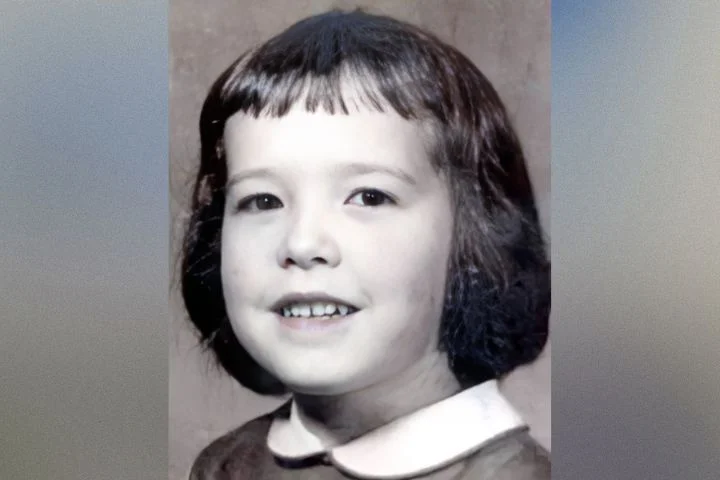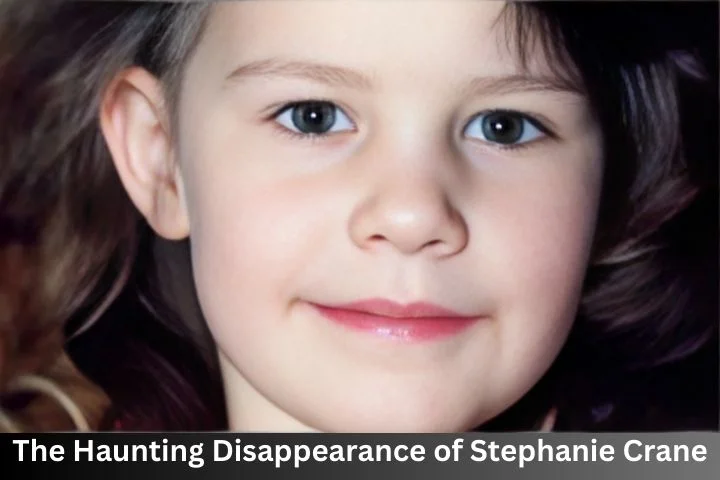Kathy Shea was extremely excited about going back to school on March 18, 1965. The past few weeks hadn’t been a lot of fun for the kindergarten student. First she had to have her tonsils taken out, and then she caught chicken pox while she was still recovering from surgery. She had to miss quite a bit of school because of this, but she was finally feeling better and couldn’t wait to get back to class to see her friends. She was enrolled in the afternoon kindergarten class at Adams Elementary School, which meant she didn’t have to leave for school until after lunch each day.
Born on February 2, 1959, Kathy was the oldest of three children, and she was the only girl. She lived with her parents and two younger brothers in a modest house on 14th Street in Tyrone, Pennsylvania. Her mother, Mary Alice, was like most other women at the time and did not work outside the home. On March 18th, Mary Alice made lunch for Kathy and her brothers, then began getting Kathy ready to go outside. The official start of spring was only days away, but it was still bitterly cold. Kathy’s school was only four blocks from her house, but her mother didn’t want to risk her getting sick again and bundled her up for the walk. In addition to her school clothes, Kathy left the house in a heavy coat that had a fur collar, a hat with ear flaps that pulled down, and yellow and black boots. As she stepped out of front door, her father was pulling into the driveway. James Shea, a foreman at a local paper mill, had come home to eat lunch. He asked Kathy if she wanted him to drive her to school so that she didn’t have to walk, but she told him that she would rather walk because she liked walking in the snow. She gave her dad a hug and a kiss and headed down the street at 12:10pm.
Almost all the children who lived in Tyrone in 1965 walked to school. Three times a day — before class, at lunchtime, and after class — the sidewalks of the small town were clogged with children walking back and forth with minimal adult supervision. Tyrone had a couple of adult crossing guards, but they were stationed at only the busiest intersections. A group of older students, known as patrol boys, monitored the intersections that didn’t have much traffic.
Although Kathy was excited about going back to school, she took her time walking there. She hadn’t been allowed outside when she was ill, so she was enjoying the fresh air. Two housewives saw her as she neared 16th Street, jumping into puddles with her bright yellow boots. She chatted briefly with one of the women, and the woman said Kathy had seemed to be in a good mood. A crossing guard joked with Kathy as he helped her cross 16th Street, telling her that she would be late for school if she didn’t hurry up. She grinned up at him and continued on her way. The southern playground at Adams Elementary bordered 17th Street and was less than a block away. It should have taken Kathy only a minute or two to get there, but she never arrived.
Kathy’s cousin, Susan Rhoades, was in 6th grade at Adams Elementary. She went home every day to eat lunch, and would often see Kathy when she was walking back to school. Whenever she saw Kathy heading towards her, she would wait for her to catch up and then the two girls would walk together for the last block or so of the walk. She didn’t see Kathy this day, though, because she didn’t take her normal route back to school. Susan had a crush on the patrol boy who was stationed at 17th Street and Adams Avenue, but she was upset over something he had said to her in school that morning. She purposely took a back way to school so that she wouldn’t have to pass that intersection and see him. It was a decision that would haunt her for years. She couldn’t help but wonder how differently things might have turned out if she had taken her normal route to school and met up with Kathy like she usually did.
Kathy’s kindergarten teacher, Judy Ferrari, had only recently graduated from college and was in her first year as a teacher. When she noticed that Kathy wasn’t in class that day, she wasn’t concerned. She knew Kathy had been ill and assumed that the little girl had simply stayed home from school. At the time, schools did not phone home when a student was absent like they would in later decades, but Judy made a mental note to call Kathy’s mother after school to check and see how the little girl was feeling,
Mary Alice grew concerned when Kathy didn’t return home from school at the normal time. By 4:45pm, she was worried enough that she began calling Kathy’s friends, asking if anyone knew where the little girl was. No one had seen her. Judy Ferrari was just walking in her front door when she got a call from Mary Alice, who asked her if Kathy had been in class that day. When Judy told her that she hadn’t been, both women realized something was seriously wrong. Judy immediately walked out the door and headed back to the school. She and a small group of people began searching through the entire school, checking the basement, every classroom, and every closet. By 5:30pm, it was clear that Kathy was not in the school, and her parents called the police.
Within the hour, the search for Kathy would grow into the most massive search in the town of Tyrone’s history. As the sun set and it began to get even colder, hundreds of people came out and joined in the search for the missing little girl. Immediately recognizing the seriousness of the situation, police called for backup. They were joined by firefighters, fire police, Civil Defense personnel, members of the National Guard, and a Boy Scout troop. Bloodhounds were brought in to see if they could track where Kathy had gone. Beginning at Kathy’s house, the bloodhounds were able to pick up a trail that headed for the school. Friends and family were able to confirm that it was the same route Kathy had walked. About 100 yards from the school, the dogs veered off onto Garfield Street, and it was there that they lost the trail. No one was quite sure what to make of it. They found nothing to indicate a struggle had taken place. There was no blood, no sign of Kathy’s hat, mittens, or other articles of clothing. It was almost impossible to believe that someone could have abducted Kathy so close to her school, but the dogs followed this trail three separate times and without deviation.
Everyone was hoping that Kathy was simply lost, not kidnapped, but knew that they had to find her fast as the temperature was well below freezing. As the hours passed without any sign of her, the atmosphere got much tenser. The next morning, even more volunteers joined in the search for Kathy. Industrial workers were given time off of work to help. The local high school sent varsity athletes, students from the carpentry workshop, and members of the student council. The school district even arranged for a substitute teacher to cover Judy Ferrari’s kindergarten class so that she could help in the search for her missing student. The initial search lasted 11 days. Search teams worked around-the-clock trying to find Kathy. Led by the Civil Defense, it would involve over 3000 volunteers and over 75,000 man power hours. The community pulled together to support Kathy’s family and those who were out searching for. Local bakeries, meat packers, and grocery stores donated food, and scores of women volunteered their time in the kitchen at Adams Elementary to make sure that all those involved in the search would have something hot to eat each day.
If Kathy could have been found by sheer willpower alone, the search would have been over in minutes. But despite all their best efforts, no trace of her was found. Search parties had combed through every inch of town, both inside and outside. Every attic, basement, crawl space, dumpster and garage had been searched. They went through woods, streams, backyards, and abandoned cars. Police concluded that Kathy had to have been taken out of town, and the FBI was called in to assist in the investigation.
While search teams were out looking for Kathy, detectives were trying to piece together what had happened to the little girl. They began interviewing Kathy’s family, friends, and neighbors about anything they might have seen or heard the previous day. Based on what witnesses told them, detectives knew that whatever had happened to Kathy happened less than a block from the school. If the tracking dogs were correct, Kathy had most likely gotten into a vehicle when she was less than half a block from school. That would mean that someone had managed to get the six-year-old into their car without attracting any attention at all from the other children, neighbors, and patrol boys that were in the area.
Detectives began going from door-to-door, speaking with everyone who lived along the route Kathy had taken to school. Beth Ann Fuoss lived a couple of blocks from Adams Elementary, where her daughter was a student. Beth’s daughter went home each day for lunch and then walked back to school. On the day that Kathy disappeared, Beth’s daughter had left for school around 12:15pm like she normally did. Beth had just waved goodbye to her and was standing in her front yard when she noticed a man she didn’t recognize driving down the street in an old-looking car. There was nothing suspicious to make the car stand out, and Beth was only vaguely aware of it as it passed by her house. Kathy walked by a couple of minutes later, and Beth spoke with her for a minute or so before Kathy continued her walk to school. It wasn’t until she heard Kathy was missing that Beth remembered the car and wondered if it had anything to do with her disappearance.
A school patrol boy told detectives about a strange event that had taken place a few months before, in either November or December. The boy was helping students across an intersection near the school when he was approached by a man he didn’t recognize. He told detectives the man had been white, about 50 years old, with a deeply tanned face. His hair and eyebrows were dark, and he had a dark beard. The man asked the boy if he knew who Kathy Shea was, and when he said that he did, the man asked him to point Kathy out for him. The boy pointed towards Kathy, who was standing nearby with two of her friends, and the man then left. The car the man was driving was dirty and dark brown in color, but the boy didn’t know what kind of car it was and couldn’t remember if it had two or four doors. Although the man’s questions had been unexpected and somewhat unusual, the boy didn’t think it was anything he needed to worry about. It was 1965, decades before “stranger danger” would become a media catchphrase. Children viewed strangers as a curiosity, not something they needed to fear. By the time Kathy went missing in March, the boy had forgotten about the incident. When other witnesses reported seeing a man matching this description parked near the Adams Avenue and West 17th Street intersection on the day Kathy went missing, detectives began trying to determine the identity of the man, but had no luck.
A few people saw a younger white male, around 25 years old, driving an aqua colored car on West 14th Street on the day that Kathy disappeared. He was described as being nice looking, with dark wavy hair. He was wearing a light-colored dress shirt and a sports jacket. One witness reported that the man had stopped her near the intersection of Blair Street and West 14th Street and asked for directions to Plank Road, in Altoona. He tried to get the witness to get into the car with him to show him where to go, but she refused. He was last seen driving north on Blair Avenue. There was nothing in particular that suggested he was responsible for Kathy’s disappearance, but the fact that he was a stranger to the town raised the witness’s suspicions. Police would eventually release a composite sketch of both this man and the older man who had spoken with the patrol boy, and they were printed on the front page of the local newspaper. Detectives were hesitant to call either of the men suspects in the case, but they wanted to talk to them because they had been in the area when Kathy disappeared and may have witnessed something of importance to the investigation. Despite extensive media coverage, investigators were never able to determine the identity of either man.
Some witnesses had observed an old green car parked near Adams Elementary shortly before Kathy went missing. It stuck out because it was parked at an angle to the curb in an area that was reserved for parallel parking. Witnesses could that the driver was sitting in the car, but they were unable to provide detectives with a description. After reports of the green car were made public, a woman who worked at a nearby candy store called police to say that a thin, unshaven man who was driving a car had come into the candy store on Friday, the day after Kathy went missing. The man purchased a popsicle and a banjo, and when he was leaving, the employee noticed that there was a young girl in the car with him. Police were never able to determine if this car was related to Kathy’s disappearance or not.
Months went by without any progress in the investigation. Police had no suspects, and they had no idea if Kathy was alive or dead. When school started up again in the fall, circulars with Kathy’s picture were mailed to school districts across the United States. There was a possibility that someone had abducted Kathy in order to raise her as their own child, which meant that she could be enrolled in school somewhere. Plans were made to send these circulars to all fifty states in the hopes that Kathy was out there somewhere.
The residents of Tyrone struggled to regain some sense of normalcy in the aftermath of Kathy’s disappearance, but in many ways the town would never be the same. Prior to 1965, parents rarely drove their children to school. This changed after Kathy went missing, and children no longer enjoyed carefree walks without adult supervision. Most parents began dropping their children off at school in the morning and then returning to pick them up in the afternoon. Other parents would make the walk to and from school with their children. Groups of parents calling themselves “Parent Watchers” would patrol the streets before school, at lunchtime, and again after school. They kept an eye out for anything or anyone that looked suspicious.
Children were still allowed to play outside after school, but their parents were much more cautious and kept a closer eye on them. In the years before Kathy went missing, children recalled how they would arrive home from school, change out of their school clothes, and then run right back out the door to meet up with their friends. Mothers wouldn’t ask where they were going, they would simply call out a quick reminder that they needed to be back by dinner. The paper mill in Tyrone had a whistle that would blow at the end of the workday, and children knew when they heard that sound that it was time for them to return home for dinner. After Kathy’s disappearance, children found themselves on tighter leashes. Mothers wanted to know where their children were at all times, and a child who was late getting home ran the risk that his parents would call the cops out of fear that he had been abducted.
Parents began to realize that there were no safeguards in place to let them know if their child didn’t make it to school in the morning. If the school had a policy of calling parents whenever their child was absent, Kathy’s disappearance would have been noticed far earlier. By the next week, volunteers started going through the school’s absentee list each morning. They would call the parents of every child who was on the list just to make sure everything was okay, a practice that is now considered standard all over the country.
Time went on, and the case fell out of the headlines. Kathy was never forgotten — local papers still run a recap of the story each year on the anniversary of the disappearance — but the horror that had gripped the town slowly began to fade. It’s been more than fifty years since Kathy began the walk to school that she would never finish, and police still have no idea what happened to the little girl. As detectives retire each year, new detectives are brought in to replace them, and they all end up looking through Kathy’s file at some point. They are just as mystified by her disappearance as detectives were on the day that it happened.
Through the years, various theories about what happened to Kathy have emerged. Detectives were able to rule out several possibilities almost immediately. They did not believe that Kathy had run away from home or had inadvertently gotten lost on her way to school, and they never considered her parents to be suspects in her disappearance. They were certain that Kathy had been abducted. But despite all the work they put into the investigation, police were never able to identify any suspects in the case. The question of who abducted Kathy — and why — is still being asked more than five decades after she went missing.
Police considered the idea that Kathy had been abducted by someone who was unable to have children and wanted to raise her as their own child. For parents clinging to the hope that their child is alive, this is the preferred scenario as it allows them to believe that their child is being taken care of and loved. In reality, abductions of this kind are extremely rare, and Kathy’s age makes it especially doubtful in this case. Most abductors who kidnap a child and pretend it is their own gravitate towards infants. This is because they will often fake being pregnant for one reason or another, and after a while they know they will have to produce a baby in order for their ruse to continue to work. But Kathy was six. She was in school, she already knew how to talk, and she was learning to read. It would have been much harder for someone to give her a new name and immediately assimilate her into their family. Even once she got older, she would have retained some memories of her childhood. Her disappearance made national headlines and was still occasionally discussed in the media decades later. If she was alive somewhere, it is very likely that she would have seen something about the case over the years and would have come forward.
Tyrone was a very small town, and residents were quick to notice any strangers. The day Kathy disappeared, detectives received reports about two different unknown males that had been seen near Adams Elementary. Two patrol boys had observed an older male sitting in his parked car near the school, and a housewife had seen a younger male driving around town. Police found no conclusive evidence linking either of men with Kathy, but residents were convinced one of them had to have been the person who took Kathy.
After hearing the description of the older man that the two patrol boys had observed, a third patrol boy came forward and told detectives he had seen the same man three or four months before — and he had been asking about Kathy Shea. If this were correct, it could mean that Kathy’s abduction had been planned out months in advance, and the fact that the man needed to have Kathy pointed out to him seems to indicate that he didn’t know the little girl. But why would someone want to target Kathy? As far as police could determine, her family had no enemies. They weren’t wealthy — they lived in a modest house in a working class town — and there was never any contact from the abductor, making it unlikely that it was intended to be a ransom kidnapping. There is also no way of knowing just how accurate the patrol boy’s description of the man was. He had only spoken to the man for a few seconds, and he didn’t report the incident to anyone at the time it happened. It’s possible that his description was influenced by the one given by the other two boys. The length of time in between the two sightings of the man must also be taken into account. He was seen once in November or December, and then again in March on the day Kathy disappeared. There were no other reported sightings of the man. This would mean that he waited three or four months from the time Kathy was pointed out him before returning to abduct her — and he just happened to return on one of the few days when Kathy was walking to school by herself.
The year after Kathy disappeared, a teenage girl in Shade Gap, Pennsylvania, was abducted by a man named William Hollenbaugh. He held her hostage for eight days, and he earned the nickname “Shade Gap Sniper” after k*illing an FBI agent who was trying to apprehend him. The teenager, Peggy Bradnick, was safely recovered after Hollenbaugh was k*illed in a standoff with law enforcement. When detectives interviewed her about the ordeal, she told them that Hollenbaugh had told her “at least your parents know where you are. Kathy Shea’s parents don’t know where she is.” This remark caused speculation that Hollenbaugh had been the person who abducted Kathy, but police eventually ruled him out as a suspect. He didn’t know how to drive and got around by riding a bicycle. Detectives determined that even if he had managed to ride his bike from Shade Gap to Tyrone, there was no way he would have been able to carry Kathy very far without attracting attention.
The residents of Tyrone wanted to believe that a stranger had been responsible for abducting Kathy. The alternative — that it was a fellow resident or neighbor — was simply too unpalatable to be considered. Yet a resident would have had some advantages over a stranger. People were quick to notice when there was a stranger in town, but a resident would have been able to travel around without attracting any attention. While witnesses recalled seeing an unfamiliar car parked near Adams Elementary, they likely wouldn’t have noticed a resident’s car parked in the same area. Beth Fuoss, the housewife who reported seeing an unfamiliar car driving down the street the day Kathy disappeared, did not recall seeing any other cars go by. While the street she lived on was not a main road, it was relatively well-traveled. More cars probably had driven by while she was standing in her front yard, but the only one that stuck out in her mind was the one she didn’t recognize.
Although Kathy, like all children at the time, did not have a well-developed fear of strangers, she most likely would have been wary about getting in a car with someone she didn’t know. Her teacher described her as quiet and thoughtful, but not very outgoing. She was not the kind of girl who would have been comfortable chatting with a complete stranger, but she would have had no qualms about talking to someone that she recognized. If she had been approached by someone she knew, they would have been able to get her into their car without any trouble.
In the aftermath of Kathy’s disappearance, rumors about what might have happened to her began to spread throughout the town. Some people claimed that Kathy had been taken into the sewers where a network of tunnels ran underneath much of the town. One resident had poured a concrete foundation for a barn on the day Kathy disappeared, and people whispered that Kathy was buried beneath it. They were intriguing claims, but without any factual evidence to support them, police dismissed the claims as being mere talk.
Kathy has been missing for more than 55 years now. Both of her parents are dead, and her two brothers are now middle-aged with families of their own. She also has a younger sister she never got to meet. They have never forgotten Kathy, and neither have police. Her case remains open.
Kathleen Shea was only six years old when she disappeared. An age-progression photo of what she might look like as an adult can be seen on the NCMEC website, www.missingkids.org. Kathy is a white female with dark blond/brown hair and blue eyes. At the time she went missing, she was 3’11’ and weighed about 45 pounds. She was last seen wearing a brown hat, beige coat, red sweater, a brown jumper, red tights, red gloves, and yellow and black boots. If you have any information about Kathy, please contact the Pennsylvania State Police at 610–696–6100.






